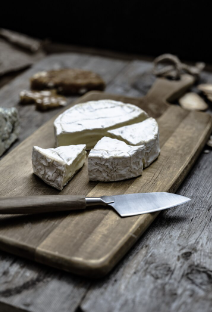The world of artisanal cheese is a boundless landscape of tradition, terroir, and relentless innovation, where centuries-old methods collide with modern culinary creativity to produce flavors that are both comfortingly familiar and thrillingly novel. Among the pantheon of great cheeses, few styles command as much passion and curiosity as bold blue cheeses, with their assertive veins of penicillium mold creating complex, pungent, and deeply savory experiences that can elevate a simple meal into a gastronomic event. While regions like Italy’s Lombardy for Gorgonzola and France’s Roquefort have long been sanctified in the cheese enthusiast’s bible, a new wave of producers from other renowned dairy cultures are adding their own distinctive chapters to this story. It is from the sun-drenched plains and rugged mountains of Spain, a country already revered for its unparalleled sheep’s milk cheeses like Manchego, that an intriguing new contender has emerged: Masgonzola. This name itself, a clever portmanteau hinting at its heritage, suggests a bold experiment—a fusion of Spanish craftsmanship with the iconic blue cheese tradition. This comprehensive review will embark on a sensory journey into the heart of Masgonzola, exploring its origins, flavor profile, texture, and the myriad ways it can be incorporated into a gourmet kitchen, ultimately determining whether it deserves a place on the board of the most discerning cheese aficionados.
Masgonzola’s fundamental genius lies in its conceptual blending of two distinct cheese worlds into a single, coherent, and magnificent product. As the name implies, it represents a marriage between the rich, nutty, and distinctly sheepy characteristics of a fine Manchego cheese, crafted from the milk of Manchega sheep, and the creamy, pungent, and sharply salty qualities of a classic Gorgonzola. The process likely begins with the base of a high-quality Manchego, which is then needled to introduce the specific strains of penicillium roqueforti mold responsible for the blue veining. The aging process that follows is where the magic truly happens, as the cheese develops its unique personality. The result is not merely a blue-veined Manchego, but a entirely new cheese category that boasts a remarkable complexity. The initial flavor profile is unmistakably Spanish: a firm, slightly crystalline paste offers notes of roasted nuts, browned butter, and the distinct grassy, pastoral essence of sheep’s milk. This rich foundation is then spectacularly interrupted by the aggressive, spicy kick of the blue mold, which delivers a sharp, salty, and intensely savory punch that lingers beautifully on the palate. The texture is a study in contrasts itself—dense and slightly crumbly like a well-aged Manchego, yet simultaneously creamy and unctuous around the delicate veins of blue, creating a mouthfeel that is both substantial and meltingly smooth.
The culinary applications for a cheese with such a bold and complex character are virtually limitless, providing a powerful tool for transforming everyday dishes into restaurant-quality experiences. Firstly, as a table cheese, Masgonzola commands attention on a charcuterie board, where it can be paired with sweet accompaniments like fig jam or quince paste to balance its saltiness, with dry, nutty crackers to complement its texture, and with slices of salty Iberico ham to amplify its savory Spanish soul. Beyond the board, it becomes a secret weapon in the kitchen. Its ability to melt into a rich, flavorful sauce makes it ideal for gourmet pasta dishes, risottos, or draped over a perfectly grilled steak, where it adds a depth of flavor far beyond a standard blue cheese. Crumbled over a salad of bitter greens, pear, and walnuts, it provides a salty, creamy counterpoint that ties all the elements together. For the adventurous home cook, it can be baked into savory tarts or stirred into a sophisticated dip. The presence of Masgonzola in a recipe ensures a conversation-starting depth of flavor, leveraging the familiarity of blue cheese while surprising the palate with the unique, nutty undertones of its Spanish heritage. It is a cheese that doesn’t just accompany a meal but actively defines it, encouraging culinary creativity and a deeper appreciation for the art of cheese-making.
Conclusion
In final analysis, Masgonzola stands as a triumphant testament to the innovative spirit alive in the world of artisanal cheese-making. It successfully achieves what many fusion products attempt but seldom master: it creates a harmonious and entirely new flavor experience that respectfully honors its parent traditions while boldly asserting its own unique identity. This is not a gimmick but a seriously crafted cheese that offers a compelling alternative for blue cheese lovers seeking something beyond the usual suspects and for devotees of Spanish cheese looking to explore a more adventurous profile. Its complex interplay of nutty, sweet sheep’s milk and sharp, salty blue mold makes it exceptionally versatile for both straightforward enjoyment and complex culinary applications. For anyone curating a cheese board meant to impress, seeking a standout ingredient to elevate a home-cooked meal, or simply wanting to explore the exciting frontiers of modern cheese production, Masgonzola is an essential and rewarding discovery. It embodies a delicious dialogue between Italian and Spanish dairy traditions and firmly establishes itself as a modern classic worthy of celebration.
Frequently Asked Questions (FAQ)
Q1: What exactly is Masgonzola cheese?
A: Masgonzola is an artisanal blue cheese from Spain. It’s a fusion cheese that combines the rich, nutty characteristics of a traditional Manchego cheese (made from sheep’s milk) with the sharp, pungent, and veined qualities of a Gorgonzola-style blue cheese.
Q2: How does Masgonzola taste different from regular Gorgonzola?
A: While traditional Italian Gorgonzola is made from cow’s milk and is known for its creamy and sharply salty flavor, Masgonzola has a more complex base. You’ll first taste the distinct, nutty, and slightly sweet notes of Spanish sheep’s milk, which is then followed by the sharp, spicy kick of the blue mold. It’s a richer and more layered taste experience.
Q3: Where can I buy Masgonzola cheese?
A: As a specialty product, Masgonzola is most commonly found in well-stocked cheese shops, gourmet food markets, and online retailers that specialize in artisan Spanish products or imported cheeses. It may not be available in standard supermarkets.
Q4: What are the best pairings for Masgonzola?
A: Its bold flavor pairs wonderfully with sweet elements like honey, fig jam, or pear slices. For drinks, try a robust red wine like a Rioja, a sweet dessert wine like Port, or a rich, dark beer like a Stout. It also complements salty cured meats like Serrano ham.
Q5: Can you cook with Masgonzola, or is it just for eating on its own?
A: Absolutely, you can cook with it! Masgonzola melts beautifully, making it perfect for creating intense sauces for pasta or steak, adding to risottos, baking into savory tarts, or crumbling over salads and pizzas for a gourmet touch.
Q6: How should I store Masgonzola cheese?
A: Store it in the coldest part of your refrigerator, ideally in a dedicated cheese paper or loosely wrapped in parchment paper and then placed in a slightly open plastic container. This allows the cheese to breathe without drying out. Avoid tight plastic wrap, as it can cause the cheese to sweat and promote unwanted mold.





